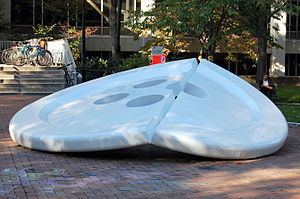Dimensions 4.9 m diameter (16 ft) Year 1981 | Created 1981 | |
 | ||
Location Philadelphia, Pennsylvania Similar Clothespin, Dropped Cone (collabor, Typewriter Eraser - Scale X, Lipstick (Ascending) on Caterp, Batcolumn | ||
The Button (officially, Split Button) is a modern art sculpture that lies at the center of campus at the University of Pennsylvania. It was designed by Swedish sculptor Claes Oldenburg, who specializes in creating oversize sculptures of everyday objects.
Contents
Specifications
Controversy
When The Button was installed in front of the Van Pelt Library on June 18, 1981, it was met with much controversy. Some students found the structure intrusive, and a poor addition to College Green. Controversy surrounding the piece has subsided in the years since 1981, but either way, it is now a central landmark and focal point of campus.
In popular culture
In The Simpsons, The Button can be seen on the college green of fictional Springfield University as Homer performs in a Nirvana-like band in the episode "That 90's Show".
Legend
A legend exists, mainly circulated by students at the University of Pennsylvania, that attributes The Button to the university's founder, Benjamin Franklin. A monument of a seated Franklin stands near the sculpture; legend has it that when this man of considerable girth sat down, his vest button popped off and rolled across the University's Locust Walk. It eventually came to a stop and split into two—hence becoming today's sculpture.
Oldenburg, however, presents an alternative view. He once said "The Split represents the Schuylkill. It divides the button into four parts—for William Penn's original Philadelphia squares."
Student life
The Button lends its name to a Penn gossip and news blog, Under the Button.
